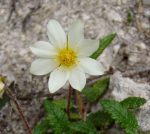 Also known as eightpetal mountain-avens, creeping oak, white dryas, or white dryad, this prostate evergreen subshrub is a circumpolar species found in the arctic tundra of northern Eurasia and North America and extending into the mountain of the Cascades and Rocky Mountains above tree line as far south as Colorado. It is a member of the rose family, Rosaceae, that also includes cherry, almond, and lady’s mantle. Growing 2.5-4″ tall, the plant forms a large mat 2-3′ across with woody stems and small, green, leaves that have scalloped margins, a smooth upper surface and woolly, matted hairs beneath. From late spring into summer, leafless stalks carry anemone-like flowers 6-8″ above the foliage. The flowers usually have 8 white petals surrounding a yellow center, but some flowers have up to 16 petals. An attractive seed head with silky feathery hairs persist into fall. Mountain avens is a good choice for a ground cover or alpine, rock, or wall gardens. The genus name, Dryas, is the Greek word for a wood nymph to whom the the oak was sacred, referring to the similarity of the leaves of this species to oak leaves. The specific epithet, octopetala, comes from the Greek words octo meaning 8, and petalon, meaning petals, and refers to the usual number of flower petals.
Also known as eightpetal mountain-avens, creeping oak, white dryas, or white dryad, this prostate evergreen subshrub is a circumpolar species found in the arctic tundra of northern Eurasia and North America and extending into the mountain of the Cascades and Rocky Mountains above tree line as far south as Colorado. It is a member of the rose family, Rosaceae, that also includes cherry, almond, and lady’s mantle. Growing 2.5-4″ tall, the plant forms a large mat 2-3′ across with woody stems and small, green, leaves that have scalloped margins, a smooth upper surface and woolly, matted hairs beneath. From late spring into summer, leafless stalks carry anemone-like flowers 6-8″ above the foliage. The flowers usually have 8 white petals surrounding a yellow center, but some flowers have up to 16 petals. An attractive seed head with silky feathery hairs persist into fall. Mountain avens is a good choice for a ground cover or alpine, rock, or wall gardens. The genus name, Dryas, is the Greek word for a wood nymph to whom the the oak was sacred, referring to the similarity of the leaves of this species to oak leaves. The specific epithet, octopetala, comes from the Greek words octo meaning 8, and petalon, meaning petals, and refers to the usual number of flower petals.
Type: Evergreen subshrub
Bloom: White flowers with usually with 8 petals surrounding a yellow center fro late spring to summer
Size: 2.5-4″ H x 2-3′ W
Light:Full sun
Soil: Average, medium moist, well-drained; often found on limestone outcrops
Hardiness: Zones 2-8
Care: Low maintenance
Pests and Diseases: None of significance
Propagation: Seed, softwood cuttings
Companion Plants: Aster alpinus ‘Goliath’, Scilla siberica, Arabis caucasica ‘Rosabella’
Photo Credit:Wikimedia